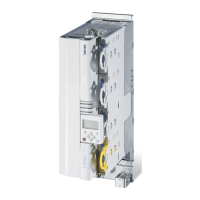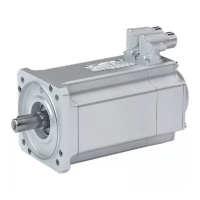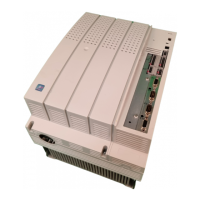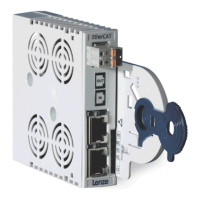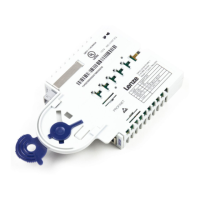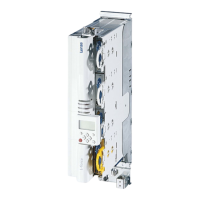Do you have a question about the Lenze AC Tech PositionServo 940 and is the answer not in the manual?
Guide on using the manual, including safety warnings and instructions for personnel.
Details the PositionServo drive package contents and initial checks upon delivery.
Information on legal compliance, CE identification, manufacturer, and liability.
Key electrical data including mains voltage, current, and output power for various models.
Specifies output power, leakage current, and power loss at different operating frequencies.
Recommends appropriate fuses and circuit breakers for AC line input and DC bus.
Details specifications for digital inputs and outputs, scan times, and voltage ranges.
Outlines required environmental conditions like temperature, humidity, and altitude for operation.
Describes the Torque, Velocity, and Position operating modes and their reference signals.
Lists and explains the various connectors and I/O interfaces on the PositionServo drive.
Provides detailed physical dimensions and weight for different PositionServo models.
Specifies minimum required clearances around the drive for effective cooling.
Covers safe and correct wiring procedures, including safety warnings.
Explains proper shielding and grounding techniques to minimize electromagnetic interference.
Details the necessity and placement of external line filters for EMI/RFI compliance.
Discusses heat dissipation and the importance of adequate airflow for drive operation.
Outlines guidelines for selecting and installing external line fuses for drive protection.
Describes the main external connectors for power, motor, and communication interfaces.
Explains the functionality and configuration of digital inputs and outputs.
Details analog signal inputs for reference and analog output signals.
Covers Ethernet and RS485 interfaces, including setup and protocols.
Guides users through selecting and configuring motors for the PositionServo drive.
Explains parameter storage, EPM module usage, and fault handling.
Covers parameters related to motor selection and data.
Details various drive parameters for modes, limits, I/O, communication, and compensation.
Explains configuration for Ethernet and RS485 interfaces, including IP addressing and Modbus.
Covers scaling and adjustment of analog input and output signals.
Details settings for digital inputs and outputs, including de-bounce and limit actions.
Defines parameters for velocity control, such as zero speed and speed window settings.
Defines parameters for position control, including error limits and timing.
Explains PID gains (P, I, D) for velocity and position control, and gain scaling.
Introduces tools for drive analysis, debugging, and parameter checks.
Describes accessing, viewing, and clearing the drive's fault history.
Explains the front panel display and navigation buttons for status viewing.
Details the meaning of each diagnostic LED on the drive's front panel.
Lists and explains common fault codes, events, and reset procedures for the drive.
Outlines the essential connections required to power up and operate the drive.
Provides a step-by-step guide for configuring the drive via MotionView software.
Explains setup for position mode, including master encoder and gearing ratio configuration.
Details how to configure dual-loop systems using primary and secondary encoder feedback.
Explains the process and conditions for enabling the drive's operation.
Guides tuning the drive's velocity performance using oscilloscope and gain adjustments.
Illustrates effects of P and I gains on motor velocity response with examples.
Shows effects of P and D gains on position error and stability with examples.
Guide on using the manual, including safety warnings and instructions for personnel.
Details the PositionServo drive package contents and initial checks upon delivery.
Information on legal compliance, CE identification, manufacturer, and liability.
Key electrical data including mains voltage, current, and output power for various models.
Specifies output power, leakage current, and power loss at different operating frequencies.
Recommends appropriate fuses and circuit breakers for AC line input and DC bus.
Details specifications for digital inputs and outputs, scan times, and voltage ranges.
Outlines required environmental conditions like temperature, humidity, and altitude for operation.
Describes the Torque, Velocity, and Position operating modes and their reference signals.
Lists and explains the various connectors and I/O interfaces on the PositionServo drive.
Provides detailed physical dimensions and weight for different PositionServo models.
Specifies minimum required clearances around the drive for effective cooling.
Covers safe and correct wiring procedures, including safety warnings.
Explains proper shielding and grounding techniques to minimize electromagnetic interference.
Details the necessity and placement of external line filters for EMI/RFI compliance.
Discusses heat dissipation and the importance of adequate airflow for drive operation.
Outlines guidelines for selecting and installing external line fuses for drive protection.
Describes the main external connectors for power, motor, and communication interfaces.
Explains the functionality and configuration of digital inputs and outputs.
Details analog signal inputs for reference and analog output signals.
Covers Ethernet and RS485 interfaces, including setup and protocols.
Guides users through selecting and configuring motors for the PositionServo drive.
Explains parameter storage, EPM module usage, and fault handling.
Covers parameters related to motor selection and data.
Details various drive parameters for modes, limits, I/O, communication, and compensation.
Explains configuration for Ethernet and RS485 interfaces, including IP addressing and Modbus.
Covers scaling and adjustment of analog input and output signals.
Details settings for digital inputs and outputs, including de-bounce and limit actions.
Defines parameters for velocity control, such as zero speed and speed window settings.
Defines parameters for position control, including error limits and timing.
Explains PID gains (P, I, D) for velocity and position control, and gain scaling.
Introduces tools for drive analysis, debugging, and parameter checks.
Describes accessing, viewing, and clearing the drive's fault history.
Explains the front panel display and navigation buttons for status viewing.
Details the meaning of each diagnostic LED on the drive's front panel.
Lists and explains common fault codes, events, and reset procedures for the drive.
Outlines the essential connections required to power up and operate the drive.
Provides a step-by-step guide for configuring the drive via MotionView software.
Explains setup for position mode, including master encoder and gearing ratio configuration.
Details how to configure dual-loop systems using primary and secondary encoder feedback.
Explains the process and conditions for enabling the drive's operation.
Guides tuning the drive's velocity performance using oscilloscope and gain adjustments.
Illustrates effects of P and I gains on motor velocity response with examples.
Shows effects of P and D gains on position error and stability with examples.
| Operating Modes | Position, Velocity, Torque |
|---|---|
| Protection Class | IP20 |
| Feedback | Resolver |
| Communication | CANopen, PROFIBUS |
| Operating Temperature | 0°C to +45°C |
| Relative Humidity | 5% to 85%, non-condensing |
| Storage Temperature | -25 to 70 °C |

